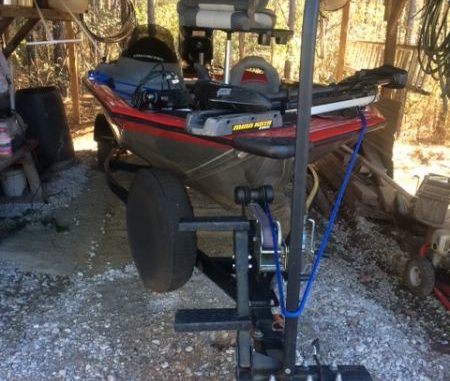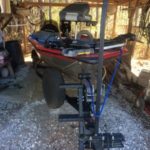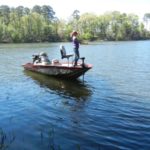
Ensure you have a fun day on the water
I’m usually a little late getting started with spring fishing because hog hunting with the dogs fills the gap between the close of deer and opening of turkey seasons.
Then chasing the gobblers uses up most of April.
But this year was a little different. We had some catching up to do.
A busy schedule last summer, combined with mechanical problems with our antique outboard, kept me and my wife Mitzi off the water for most of the summer.
But we found a good deal on a late-model boat and motor, and don’t anticipate any time-consuming projects during the next few months. So we plan to spend lots of time in the boat.
Mitzi loves to fish, so if I start to get a little lazy, she won’t hesitate to gently nudge me toward the lake.
But before we ever launch the boat for the first trip of the summer, I am all about getting prepared and properly equipped. For me equipment maintenance and assembling the necessary safety and emergency gear are a must.
Let’s go through the process together and try not to miss anything we may regret later.
First, don’t wait until an hour or so before leaving to get things ready. I set aside a few hours on a day well in advance of the first trip for prep time. Do the initial inspection with the boat still on the trailer in the barn or wherever your boat is stored. Pull the cover off the boat, climb aboard and start at the bow.
Check the bow running lights for broken bulb(s) or lenses. If the boat is equipped with a bow-mounted trolling motor, make sure it will transition easily from stowed to operating position and will lock in both positions securely.
Tighten any loose mounting screws, and make sure the wiring is not showing signs of wear.
The bow rope is next, and it is the most basic and important item up front. Make sure the bow rope is tied securely to the bow ring or cleat. Use a strong, good-quality line that will coil easily and resists twisting and tangling.
I like a long bowline, almost the length of the boat. It does not have to be that long, but do make sure it is long enough to tie off the boat with plenty to spare. The extra length comes in handy, particularly if the boat needs to be towed due to engine failure.
Move to any front deck or forward dry storage compartments. The fire extinguisher should be stored here, never anywhere rear of the operator’s seat. In the event of a fire the operator and passengers should be able to move toward the bow, retrieve the extinguisher and activate it while well clear of any smoke or flames.
Make sure the fire extinguisher is a Type B and in good working order. Replace old extinguishers, and carrying two is a good idea.
Personal flotation devices should also be in forward compartments while the boat is in storage. Take them out and check for damaged or broken straps or buckles.
Are the PFDs the proper sizes and fit for everyone who might be on oard? Have the kids or grand kids had a growth spurt and outgrown last year’s model?
And remember that one Type IV is required on boats 16 to less than 26 feet in length, in addition to the wearable type I, II, or IIIs required for each person onboard.
Old game warden habits die hard, so I like to carry a couple of towels, hand sanitizer, sunscreen, a first aid kit and light rain gear in a forward dry storage area, as well.
That’s also a good place to keep the boat registration, a flashlight; a hand-operated horn, whistle or bell ; and day and night visual distress signals.
I know the nighttime distress signals are only required on federally controlled waters, but it’s a good idea to have them anywhere. Remember the daytime distress signal and sound-producing device are required on the 16 to less than 26 feet boats everywhere.
Speaking of old habits, I rarely see boat paddles now days. But I always keep one aboard. Engines quit and batteries go dead, and a boat paddle might be the only means of getting to shore or to something we can tie off to while waiting for help.
Besides, it’s just plain handy at times.
Let’s move to the operator’s seat and check a few things.
The most-important item here is the engine cut-off switch and lanyard. Make sure to have a good, quality switch link on the lanyard that will attach to the operator’s clothing or PFD. Check it by leaning away from the normal operating position to be sure it will break away properly and shut the engine down.
Practice re-attachment and engine re-start, because if the cut-off switch is used as it should be there will be times when the operator forgets to remove the link after turning the engine off and moving from the operator seat.
I cannot over-emphasize the importance of using the cut-off switch.
Take a look at the gauges if the boat is equipped with any. Turn on the ignition switch and check voltage and fuel gauges. Check bilge pump, light and any other switches.
If the boat has speed and RPM gauges they will have to wait until the boat is in the water.
Give the steering wheel a turn to left and right. Does it feel smooth and turn easily, and is the outboard responding?
The stern storage area (and/or engine compartment for inboards and stern drives) must be thoroughly inspected because it is the most-likely source of all sorts of trouble.
With fuel, oil, batteries and electrical wiring all packed snugly together, the greatest threat here is fire. Look closely for any evidence of fuel or oil leaks. Examine fuel lines, power trim pump, oil reservoir and any other fuel or oil systems and filters.
Wipe away any oily residue and clean up fuel or oil spills.
Check the batteries to make sure they will accept and hold a charge. If the boat has been stored all winter in an area exposed to cold temperatures, it might be time to replace old batteries.
Make sure connections on the battery posts are clean and snug. Clean away any acid buildup.
Examine all wiring carefully, looking for worn coating or contact between bare wires and metal. I have seen wiring in some poorly maintained boats so old that all the insulating material had rotted away, leaving completely exposed wires.
Take a look at the bilge pump. Make sure it is in working order and clear of any sand, mud or vegetative matter that could block the pump. If the boat has an inboard drain plug, this would be a great time to install the plug. I have been known to wait until after launching and standing ankle deep in water in the boat before plugging the drain, but it’s better to do it before then.
OK, we can now climb out of the boat and move on to the exterior hull and trailer inspections. But let’s stop for a moment and talk about getting out of the boat while it is on the trailer.
One of the most-common workplace injuries among Louisiana Department of Wildlife and Fisheries employees is falling while trying to climb in or out of a trailered boat. If your boat trailer is not equipped with step plates on the tongue and/or sides, I strongly recommend installing them. Many after-market models are available, and more and more new trailers are factory equipped with safety steps.
When inspecting the exterior hull and transom, get under the boat and look for any cracks or dents. Older aluminum boats have been known to develop pits or cracks in the transom. Minor ones can sometimes be repaired. I once sealed some small holes from pitting with JB Weld. Years later that transom still does not leak.
Take a look at the boat registration numbers and decal on both sides of the bow. If the numbers are legible and the decals are current we can move on to the trailer.
The most-common problems here are worn tires and bearings. Check tires — including the spare — for wear and proper inflation. I recommend a thorough inspection of the wheel bearings to start off the season. Look for signs of wear and check for any slack or misalignment. Repack or grease the bearings, and if they are equipped with fittings add a shot or two of grease from time to time.
Now, back your vehicle up to the trailer and plug in the lights. Have someone sit in the driver’s seat and turn on the lights while you stand behind the trailer and check running, brake and turn signal lights.
Finally, is the license plate current and firmly attached? If so, you are all set and well prepared for the first voyage of the season.
We will talk more about boating safety this summer. If anyone has questions or would like to have any particular regulations or safety procedures addressed, just e-mail me at klacaze15@att.net.
Boat safe, boat sober.




